"We are what we repeatedly do. Excellence, then, is not an act, but a habit." --Aristotle
Address any questions or comments regarding this newsletter to the individual authors listed after each article or to its editor, Rick Weinzierl, 217-333-6651, weinzier@illinois.edu. To receive e-mail notification of new postings of this newsletter, call or write the same number or address.
In This Issue:
Upcoming Programs (listings for beginning and established growers)
Regional Reports (from southern and western Illinois)
Fruit Production and Pest Management (San Jose scale and spotted wing Drosophila)
Vegetable Production and Pest Management (downy mildew of basil, pumpkin insects, corn earworm)
Local Foods Issues (GAPs webinars October 7-28)
Upcoming Programs
Check the Illinois SARE calendar for a full list of programs and links for registration.
http://illinoissare.org/ and http://illinoissare.org/calendar.php
Also see the University of Illinois Extension Local Food Systems and Small Farms Team's web site at:
http://web.extension.illinois.edu/smallfarm/ and their calendar of events at http://web.extension.illinois.edu/units/calendar.cfm?UnitID=629.
- University of Illinois Pumpkin Field Day, September 2, 2015. 10:00 a.m. – 2:00 p.m. at the University of Illinois Vegetable Crops Research Farm. Topics include varieties, production systems, herbicides and weed control, insect management, pumpkin disease management, spray equipment, post-harvest issues, and marketing. Registration and lunch are free, but pre-registration is requested to allow preparation of lunches. See https://web.extension.illinois.edu/units/event.cfm?UnitID=629&EventID=68197, email Mohammad Babadoost (babadoos@illinois.edu), or call Devin Quarles at 217-333-5299.
- Illinois Specialty Crops, Agritourism, ad Organics Conference, January 6-8, 2016. At the Crowne Plaza Hotel and Conference Center, Springfield, IL. More to come in future issues of this newsletter ... for now, save the date.
Regional Reports
From southern Illinois ... We have gone directly from summertime heat to the feel of fall in southern Illinois, with the start of this week with clear sunny skies and lows in the mid to upper 50s and highs in the upper 70s to around 80. We have had some rain – around 1.3 inches in Murphysboro – over the last 10 days.
This weather has been great for the ripening apple crop, and harvest of the early apples including some 'Gala' and even just a few early 'Jonathan' is underway. The peach season is winding down, but there still are some late peaches on the market.
Pumpkins are looking good, and for the most part they have not been stressed for moisture. Powdery mildew, cucumber beetles, and squash bugs are on the radar of most growers. I personally have not observed or received any calls on any downy mildew in pumpkins, however growers have been including preventative fungicides against this disease and powdery mildew. At home it's not hard to find some mature fruit, especially on early-maturing varieties. Remember we still have yield potential left with new flowers setting now and really for the next few weeks. Generally, in this part of the state it takes, on average, around a month from flowering to mature fruit with decent weather, so the blooms that are now setting fruit may yield pumpkins that ready the beginning of October. This being said, it is very important to maintain good vine health for the next month in order to realize the benefit from the fruit setting now. If the vines go down from insect or disease pests, those fruits likely will not mature.
The vegetable season is starting to slow down, with many main season vegetable plantings, especially tomatoes, winding down quickly. Leaf diseases and fruit cracking have been major issues this season with the amount and frequency of rains we have had, and stink bugs also seem to be very plentiful. There are still many late plantings and fall vegetable plantings that have done well especially with fairly timely rains and now more modest temperatures.
Nathan Johanning (618-939-3434; njohann@illinois.edu)
From western Illinois ... We finally dried out. Thus far in August I've recorded a little less than 2 inches of rain. After the floods of May and June, we couldn't escape rains in July, as I recorded almost 10 inches during that month. Crops that survived those wet conditions have experienced some issues, and some of those crops are still recovering. I didn't think I'd be saying this at all this year, but a nice rain would be welcome now, as root systems are extremely compromised and soil conditions are not favorable.
I know of several pumpkin growers who have very little or no crop at all this year. This is due to the large amount of untimely rains during June, which is our traditional planting time. One grower planted on 3 separate occasions, only to have heavy rains and saturated soils suffocate the newly planted seeds. Only during the past week have I taken notice of plants growing "normally." Many of the plants have limited vines and growth, but the soil is finally drying out enough now to facilitate normal growth. Even so, we've got a lot of bare soil between plants, so we're all hoping for warm and sunny.
Homeowners have very few if any tomatoes (and other crops) due to the wet summer weather, which helps those producers who do have product to get it marketed. A few growers have late tomatoes that will begin harvest anytime now. High tunnel growers still have the best looking crops overall, simply due to their ability to control soil moisture levels.
Powdery mildew in cucurbit crops is not uncommon. I've not yet heard of any downy mildew from area growers. Late sweet corn has all the diseases that are common – rust, northern corn leaf blight, gray leaf spot, etc. Many high tunnel tomatoes have had serious issues with leaf spot. To effectively control leaf spot of tomato, coverage is critical. In a high tunnel environment, use of backpack motorized sprayers allows thorough coverage and the ability to allow navigation between aisles. Several are on the market. You can also construct your own.
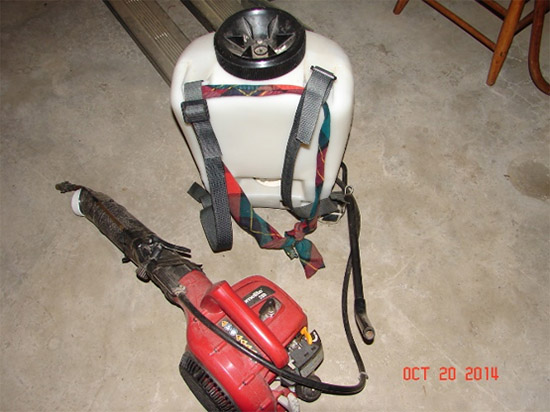
Backpack sprayer connected to a leaf blower for use as a mist-blower.
I've had issues with yellow shoulder and white core in our high tunnel tomatoes on and off for several years. In an effort to remedy that situation, after many soil tests and plant analysis, I came to the conclusion that the pH in our irrigation water is too high. Our soil tests would come back good, but for some reason the plant analysis always indicated a shortage of potassium. We contacted the rural water district, and they informed us that the pH of the water is between 7.1-7.3, which must have been causing potassium to be unavailable to the plant. For the past month I've been placing sulfuric acid in the injector each time we water and now am happy to state the tomatoes are excellent.
I've noted cercospora blight in our asparagus a couple weeks ago and have initiated a spray control program to prevent more loss of foliage. We have to battle cercospora every year or two. The disease causes the leaves of asparagus to die prematurely, which can result in premature plant death, which leads to less photosynthesis to provide energy for spear growth next spring. Lesions will begin on the lower part of the plant and if conditions permit, will progress upwards on the plant. Lesions are oblong, with a light gray center surrounded by a darker margin. Control recommendations can be found on the 2015 Midwest Commercial Vegetable Production Guide (https://www.btny.purdue.edu/Pubs/ID/ID-56/).
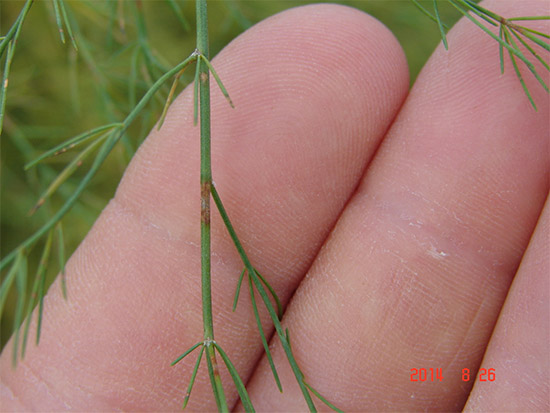
Cercospora blight on asparagus.
Remember that if you're planning on any fall crops, now is the time to begin planting. Make succession plantings to extend the harvest. Use low tunnels, high tunnels, row covers, or poly plastic, and you'll be able to extend harvest throughout winter in most IL locations.
Mike Roegge (217-223-8380; roeggem@illinois.edu)
Fruit Production and Pest Management
San Jose Scale on Apples
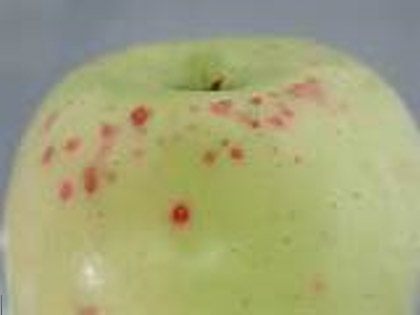
Red spots caused by San Jose scale on apple (Oregon State University).
Infestations of San Jose scale that may go unnoticed on twigs of apples often show up on fruits as apples near harvest. We have some showing up on Golden Delicious at the University of Illinois Fruit Research Farm at Urbana. This is really not the time of year to accomplish a great deal of scale control, but it is a good time to flag or map the areas of orchards where fruit is infested and plan to step up control practices for next spring. Good coverage with superior oil at green tip is the first step in early spring, and the effectiveness of this treatment can be increased by adding Lorsban, Diazinon, or Supracide. Esteem and Centaur are labeled for scale control at half-inch green or 4 to 6 weeks after bloom when crawlers are active (a higher rate is needed for the later application against crawlers). Diazinon, Admire Pro, Assail, and Movento also are labeled for scale crawler control in early summer. Admire (7-day PHI), Assail (7-day PHI), Centaur (14-day PHI), and Movento (7-day PHI) can be used at this time to prevent (or at least reduce the frequency of) fruit infestations, but with full canopies and difficulties obtaining thorough coverage of all twigs and branches, sprays applied at this time of year are less likely to provide high levels of population reduction over the long term.
Spotted wing Drosophila (SWD) in Peaches
About 10 days ago we picked some ripe (but still apparently unbruised and undamaged) Contender peaches at the University of Illinois Fruit Research Farm and held them at room temperature in tightly screened cages in the lab to see if any SWD flies would emerge (indicating that eggs had been laid on the fruit and larvae developed in the fruit after harvest. As expected, the fruit deteriorated in a few days at room temperature. We also collected lots of SWD flies in the cages over the last two days. This was not really surprising ... some of our trees were untreated checks in our trials and received no insecticide applications, and like all orchards, we have some fruit that drops and remains on the ground, allowing SWD to develop in it and move to later-ripening fruits on the tree. Where peaches are harvested and placed in cold storage, SWD development is stopped, and storage at 33 degrees F for 3 days is reported to kill nearly all larvae in the fruit. Still ... just a reminder ... SWD does infest peaches, and infestations are likely to be greater in riper fruit and in later fruits where crops of nearby earlier varieties allow population buildup. Baythroid (7-day PHI) and Danitol (3-day PHI) and other insecticides with longer preharvest intervals can be used to protect peaches from SWD infestation.
Rick Weinzierl (217-244-2126; weinzier@illinois.edu)
Vegetable Production and Pest Management
Downy Mildew of Basil in Illinois
On August 10, I observed and confirmed downy mildew of basil in our research plots in Champaign, Illinois. I expect downy mildew on basil develop throughout the state. Thus, fungicide treatment for control of this disease on green basils is essential.
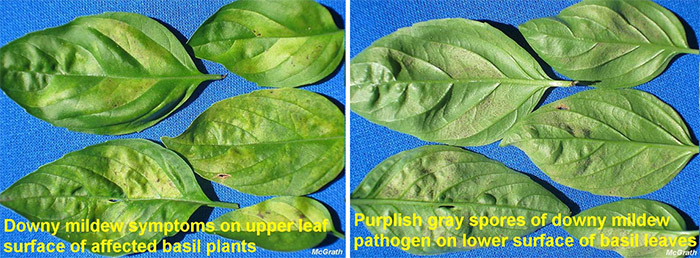
Downy mildew of basil, caused by Peronospora belbahrii, occurred first in Illinois in 2009. Since then the disease developed on basils every year. P. belbahrii infects leaves, rapidly develops and spreads, and can cause total crop loss. Since 2009, we have had trials for evaluating efficacy of fungicides for control of basil downy mildew every year. The results of our trials showed that the disease can be effectively controlled by weekly applications of the following fungicides: Quadris, Revus, and Ranman. These fungicides have different modes of action and all three are registered for use on basils. For additional information, contact Mohammad Babadoost by email at (babadoos@illinois.edu).
Mohammad Babadoost (217-333-1523; babadoos@illinois.edu)
Late-Season Pumpkin Insect Management
Most pumpkin insect problems subside in September and early October prior to pumpkin harvest, but squash bugs, cucumber beetles and corn rootworm beetles, and aphids may persist and warrant control.
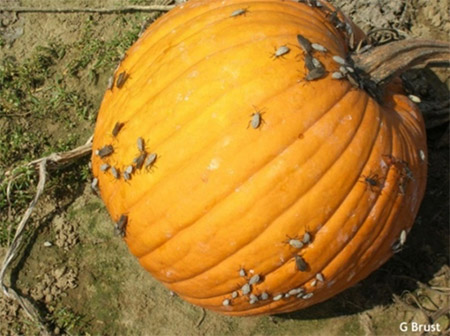
Squash bugs on pumpkin. (Photo by Gerald Brust)
Squash bugs may continue to feed on vines and directly on pumpkin fruits. As vines die down, nymphs and adults feeding directly on fruits and "handles" can cause shriveling and distortion and produce wounds that allow entry of fruit rotting pathogens. Where fruit-feeding is occurring, squash bugs can be controlled with applications of Brigade, Warrior, or Mustang Max as listed in the 2015 Midwest Vegetable Production Guide.
Spotted cucumber beetles, striped cucumber beetles, and western corn rootworm beetles also feed directly on fruits, scarring the surface, making the frit unmarketable. Their feeding sites also provide entry for fruit-rotting pathogens. The pyrethroids listed above (Brigade, Warrior, and Mustang Max), products that contain the pyrethroid permethrin (Pounce and generics), and Sevin XLR Plus are among the most effective insecticides labeled for control of these beetles on pumpkins.
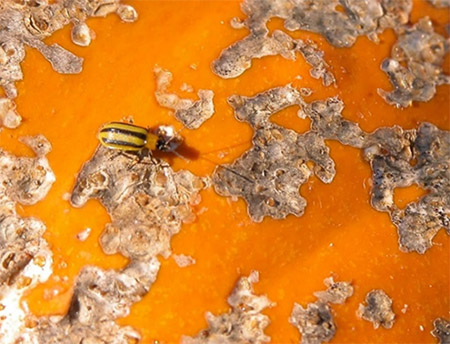
Striped cucumber beetle on pumpkin. (Photo by Ontario Ministry of Agriculture and Rural Affairs.)
As vines die down, aphid colonies move to pumpkin fruits, often around the handle and where the fruit rests on the soil. Their feeding may result in sunken areas on the fruit, and their presence, along with the honeydew they secrete, may reduce the crop's marketability. Aphid outbreaks often occur where a pyrethroid or Sevin XLR Plus has been used repeatedly through the season, killing lady beetles and other natural enemies that prey on aphids and limit their populations. Where aphid control is necessary at the end of the season, Assail, Beleaf, Closer, Fulfill, or M-Pede (or another insecticidal soap) can be used effectively. M-Pede is labeled for use in organic production; very thorough coverage is required for it to be effective. Actara and Belay are also effective aphicides, but they are especially toxic to bees, so if any late flowering is still ongoing or if there are flowering weeds in the field, it should not be used.
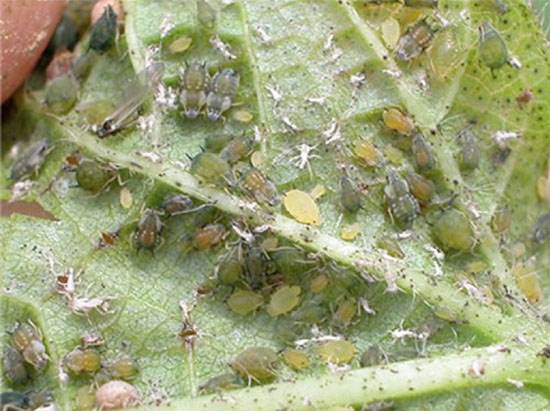
Cotton-melon aphid, Aphis gossypii (Univ. of Tennessee).
Rick Weinzierl (217-244-2126; weinzier@illinois.edu)
Corn Earworm /Tomato Fruitworm Control in Sweet Corn, Tomatoes, and Peppers
In the last week, counts of corn earworm (= tomato fruitworm) moths in pheromone traps at Urbana have increased substantially. I suspect some level of increased flight in other parts of the state as well. Although our counts (as high as 50-60 per night) do not rival the really high counts we have seen in some recent years (well over 200 per night), at this time of year such flights mean that the likelihood of damage to late sweet corn, tomatoes, and peppers is pretty high. See the 2015 Midwest Vegetable Production Guide and the February 13, 2015, issue of this newsletter for control recommendations. Be aware that some populations of corn earworm / tomato fruitworm may be resistant to pyrethroid insecticides (including Baythroid, Brigade, Mustang Max, Warrior, and others, including generics), so their use will not provide adequate control. Coragen and Radiant are the most effective alternatives to pyrethroids for earworm control. Besiege is a pre-mix of the active ingredients found in Warrior and Coragen, and it also has been effective in research trials and grower use. When moderate to large flights of corn earworm moths develop over a short period -- either as a result of immigration from the south or a second "home-grown" generation -- predators and parasites that might provide natural biotic control do not have time to build up in numbers and have much impact. Insecticides are pretty much the only option to reduce infestations and losses.
Rick Weinzierl (217-244-2126; weinzier@illinois.edu)
Local Foods Issues
GAPs Webinar Series, October 7, 14, 21, and 28; 6:00 - 8:00 pm.
University of Illinois Extension will offer a GAPs (Good Agricultural Practices for food safety) webinar series to provide information to growers on how to keep produce safe from production to the market. The past few years we've all seen and heard about examples of where food has been contaminated, and the results often have been catastrophic. Infection with E. coli and other organisms has made headlines with cantaloupe, lettuce, beef, and other foods. GAPs training discusses methods to reduce the potential for contamination. Topics in this webinar series will include: What is GAPs?; water quality and testing; soil management; record keeping; traceback, and more. It also will include updates associated with the new rules established by the Food Safety Modernization Act.
The webinar series will be held on Wednesdays, October 7, 14, 21, and 28 from 6:00 p.m. to 8:00 p.m. You may attend the webinars from your home; you will need to have a computer with high-speed internet access and a way to listen to the presentation via your computer (headsets are best, but speakers will work). Each registered participant will be sent webinar instructions, handouts, and a GAPs manual prior to the first webinar and webinar instructions before each subsequent session. The registration fee is $25 per participant. Pre-registration along with pre-payment is required by October 2, 2015. For more information, contact University of Illinois Extension, Kankakee County, at 815/933-8337.
To register, complete the form at https://web.extension.illinois.edu/registration/?registrationid=12829.
Mary Hosier (217-333-7512; mhosier@illinois.edu)
University of Illinois Extension Specialists in Fruit and Vegetable Production & Pest Management
Extension Educators – Local Food Systems and Small Farms |
||
Bronwyn Aly, Gallatin, Hamilton, Hardin, Pope, Saline, and White counties |
618-382-2662 |
|
Katie Bell, Franklin, Jackson, Perry, Randolph, & Williamson counties |
618-687-1727 |
|
Sarah Farley, Lake & McHenry counties |
847-223-8627 |
|
Nick Frillman, Woodford, Livingston, & McLean counties |
309-663-8306 |
|
Laurie George, Bond, Clinton, Jefferson, Marion, & Washington counties |
618-548-1446 |
|
Zachary Grant, Cook County | 708-679-6889 | |
Doug Gucker, DeWitt, Macon, and Piatt counties |
217-877-6042 |
|
Erin Harper, Champaign, Ford, Iroquois, and Vermillion counties |
217-333-7672 |
|
Grace Margherio, Jackie Joyner-Kersee Center, St. Clair County |
217-244-3547 |
|
Grant McCarty, Jo Daviess, Stephenson, and Winnebago counties |
815-235-4125 |
|
Katie Parker, Adams, Brown, Hancock, Pike and Schuyler counties |
217-223-8380 |
|
Kathryn Pereira, Cook County |
773-233-2900 |
|
James Theuri, Grundy, Kankakee, and Will counties |
815-933-8337 |
|
Extension Educators – Horticulture |
||
Chris Enroth, Henderson, Knox, McDonough, and Warren counties |
309-837-3939 |
|
Richard Hentschel, DuPage, Kane, and Kendall counties |
630-584-6166 |
|
Andrew Holsinger, Christian, Jersey, Macoupin, & Montgomery counties |
217-532-3941 |
|
Extension Educators - Commercial Agriculture |
||
Elizabeth Wahle, Fruit & Vegetable Production |
618-344-4230 |
|
Nathan Johanning, Madison, Monroe & St. Clair counties |
618-939-3434 |
|
Campus-based Extension Specialists |
||
Kacie Athey, Entomology |
217-244-9916 |
|
Mohammad Babadoost, Plant Pathology |
217-333-1523 |
|